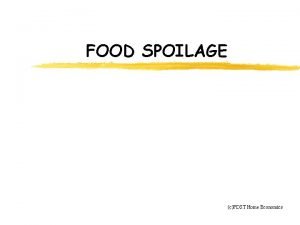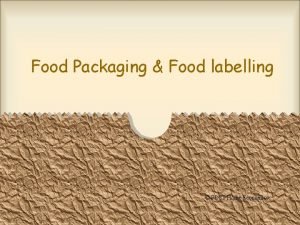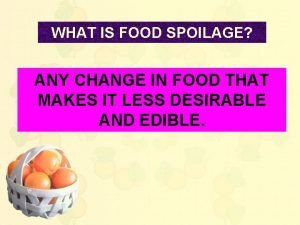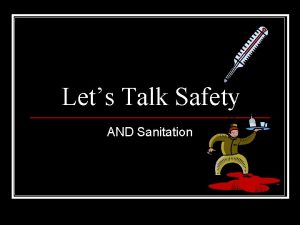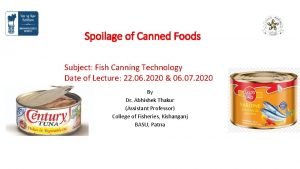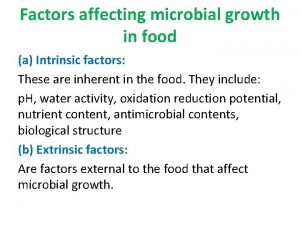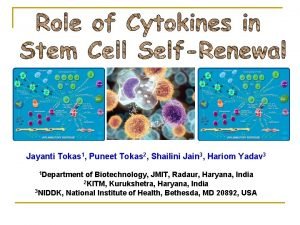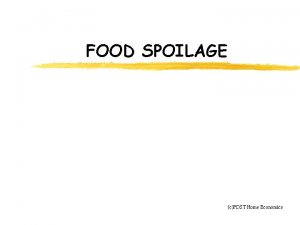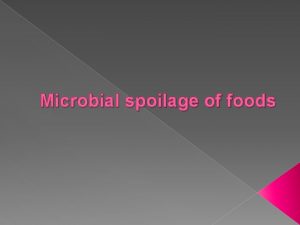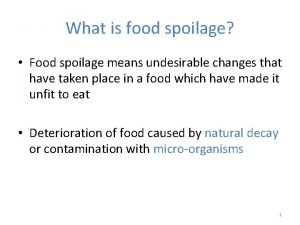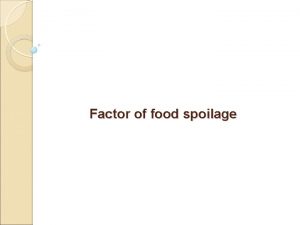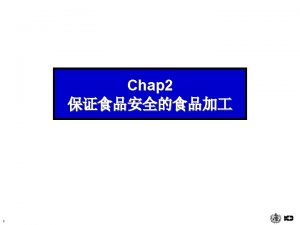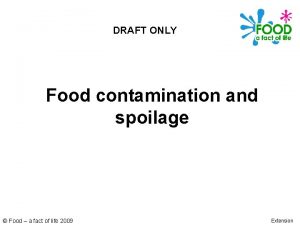FOOD SPOILAGE cPDST Home Economics CAUSES OF FOOD












- Slides: 12

FOOD SPOILAGE (c)PDST Home Economics

CAUSES OF FOOD SPOILAGE • 1. Moisture loss • 2. Enzyme action • 3. Microbial contamination

1. SPOILAGE BY MOISTURE LOSS • Mainly affects fruit and vegetables. • After harvesting they can no longer get water from the soil. • Moisture is lost through skins and leaves. • Causes wrinkling, shrinkage and limpness.

2. ENZYME ACTION • Ripening Enzymes cause food to ripen, then become over-ripe and eventually decay. Starch changes to sugar, colour changes and texture softens. • Browning When certain foods are cut and the surface exposed to air, enzymes cause them to turn brown. e. g. apples, • Enzymatic rotting Enzymes in fish cause deterioration even at low temperatures.

CONTROLLING ENZYMATIC SPOILAGE • Inactivated by heating - cooking, canning. • Cold temp slows action - cool storage. • Enzymes in vegetables work at low temperatures so they must be blanched before freezing. • Acid inactivates enzymes - lemon juice used to stop browning. • Sulphur dioxide stops enzymatic spoilage.

3. MICROBIAL CONTAMINATION • Yeast, mould and bacteria are the microbes that cause food spoilage. • Food at the optimum temperature is the ideal place for microbes to grow. • Yeast and mould spoil the outside of food and can be seen. • If the food is eaten it will probably be harmless, unless they make mycotoxins. • Bacteria cause spoilage by making toxins in food - not visible. • Souring bacteria spoil milk, yoghurt & cream.

FOOD POISONING 3 types • 1. Chemical –Caused by pesticides, antibiotics, metals. • 2. Biological – Caused by toxins naturally present in food e. g. red kidney beans, green potatoes. • 3. Bacterial - Caused by pathogenic bacteria in food

SYMPTOMS • • • Abdominal cramps Nausea Vomiting Diarrhoea Fever Loss of appetite Don’t eat for 24 hours. Drink cooled boiled water.

BACTERIAL FOOD POISONING 2 types • 1. Toxic • 2. Infectious

(H) 1. TOXIC BACTERIAL FOOD POISONING • Caused by eating food containing toxins. • Exotoxins are made by bacteria in the food before and after it’s eaten. • Exotoxins are difficult to destroy - must be boiled for 30 minutes. • Symptoms develop quickly - within a few hours of eating the food. • Exotoxins are made by Staphylococci, Clostridium botulinum.

(H) 2. INFECTIOUS BACTERIAL FOOD POISONING • Caused by eating food containing large numbers of pathogenic bacteria that produce endotoxins. • The endotoxins are released when the bacteria die in your intestine. • Endotoxins are easily destroyed by normal cooking/heating of food. • Symptoms take longer to occur - over 12 hours. • Salmonella and listeria cause infectious food poisoning.

(H) HIGH RISK FOODS • • Liquid protein foods. Milk, cream, eggs. Meat, poultry, fish. Meat dishes e. g. pies, gravies. Soups and stocks. Egg dishes e. g. custard, mayonnaise. Reheated dishes.
 Causes of food deterioration
Causes of food deterioration She said that, home economics stands for the ideal home.
She said that, home economics stands for the ideal home. Meaning of food packaging in home economics
Meaning of food packaging in home economics Define food spoilage
Define food spoilage Food spoilage signs
Food spoilage signs Food spoilage signs
Food spoilage signs Flipper in canned food
Flipper in canned food What are intrinsic factors for microbial growth
What are intrinsic factors for microbial growth Food spoilage
Food spoilage Proximate vs ultimate causation
Proximate vs ultimate causation Proximate and ultimate causes of behaviour
Proximate and ultimate causes of behaviour Economics and business economics maastricht
Economics and business economics maastricht Mathematical vs non mathematical economics
Mathematical vs non mathematical economics
